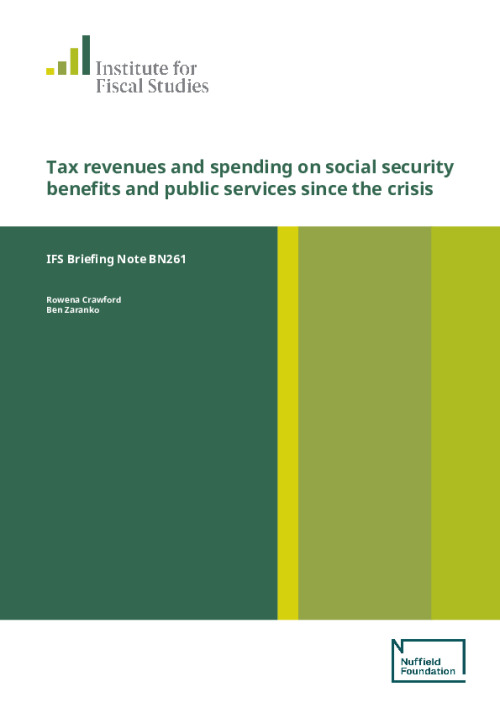In the aftermath of the global financial crisis and associated recession, government borrowing soared to more than 10% of national income. Borrowing has since been reduced through a combination of net tax rises, cuts to the generosity of the working-age social security system and cuts to public service spending. In this briefing note, we provide an overview of what has happened to each of these areas since the crisis, highlighting where (and when) the spending cuts have fallen, and consider the long-term outlook for the make-up of public expenditure.
Key findings
• The recovery in GDP per person since the financial crisis has been extraordinarily weak. Indeed, the UK has experienced its slowest-ever post-recession recovery. Official forecasts suggest that GDP per person in 2023 will be 24% lower than it would have been had it grown by 2.3% per year since 2008 (its long-run trend rate).
• Both tax rises and (to a greater extent) spending cuts have contributed to a reduction in government borrowing. Government borrowing in 2018−19 fell to 1.9% of national income, below its pre-crisis level. Current receipts exceeded current spending (i.e. non-investment spending) for the first time since 2001−02.
• Tax revenues are at their highest sustained level as a share of national income since the early 1950s. This has been driven in large part by a significant package of discretionary policy measures. Substantial tax cuts have been offset by an even more substantial package of tax rises.
• Departmental spending is now on an upwards trajectory but austerity has not been ‘undone’. Total day-to-day spending on public services is still set to be 3%lower in real terms in 2020−21 than it was in 2010−11 (9% lower in per-person terms). Outside of the Departmental of Health and Social Care, spending is set to be 16% below 2010−11 levels (21% in per-person terms).
• Discretionary government policy measures taken since 2010 mean that social security spending in 2019−20 is around £39 billion lower than it would otherwise have been. Despite these substantial cuts to the generosity of the system, spending on working-age social security as a share of national income is at around pre-crisis levels. Spending on pensioner social security is above pre-crisis levels as a share of national income and is forecast to rise from 2020−21.
• Public spending continues to be increasingly allocated to providing healthcare and pensions. The decision to prioritise and increase spending on some areas while cutting others has altered the make-up of public spending. Rising spending on health, pensions and overseas aid has been offset by falling spending on defence, education and public order and safety. Demographic and other cost pressures mean that this trend is likely to continue in the years to come.











